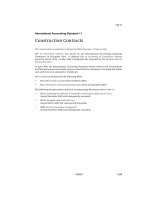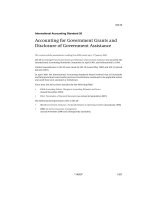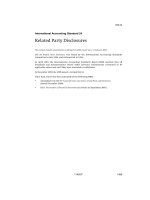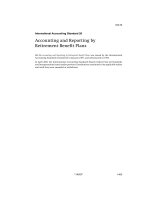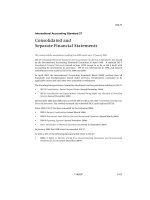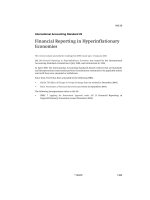chuẩn mực kế toán quốc tế ias 12
Bạn đang xem bản rút gọn của tài liệu. Xem và tải ngay bản đầy đủ của tài liệu tại đây (60.1 KB, 2 trang )
IAS 12.
Case Study 1
Facts
An entity has the following assets and liabilities recorded in its balance sheet at December 31, 20X5:
Carrying value ($ million )
Property 10
Plant and equipment 5
Trade receivables 3
Inventory 4
Trade payables 6
Cash 2
The value for tax purposes of property and for plant and equipment are $7 million and $4 million re-
spectively. The entity has made a provision for inventory obsolescence of $2 million, which is not
allowable for tax purposes until the inventory is sold. Further, an impairment charge against trade
receivables of $1 million has been made. This charge does not relate to any specific trade receivable but
to the entity’s assessment of the overall collectibility of the amount. This charge will not be allowed in
the current year for tax purposes but will be allowed in the future. Income tax paid is at 30%.
Required
Calculate the deferred tax provision at December 31, 20X5.
Case Study 2
Facts
An entity acquired plant and equipment for $1 million on January 1, 20X4. The asset is depreciated at
25% a year on the straight-line basis, and local tax legislation permits the management to depreciate the
asset at 30% a year for tax purposes.
Required
Calculate any deferred tax liability that might arise on the plant and equipment at December 31, 20X4,
assuming a tax rate of 30%.
Case Study 3
Facts
An entity has revalued its property and has recognized the increase in the revaluation in its financial
statements. The carrying value of the property was $8 million and the revalued amount was $10 million.
Tax base of the property was $6 million. In this country, the tax rate applicable to profits is 35% and the
tax rate applicable to profits made on the sale of property is 30%. If the revaluation took place at the
entity’s year end of December 31, 20X4, calculate the deferred tax liability on the property as of that
date.
Case Study 4
Facts
An entity has spent $600,000 in developing a new product. These costs meet the definition of an intangi-
ble asset under IAS 38 and have been recognized in the balance sheet. Local tax legislation allows these
costs to be deducted for tax purposes when they are incurred. Therefore, they have been recognized as an
expense for tax purposes. At the year-end the intangible asset is deemed to be impaired by $50,000.
Required
Calculate the tax base of the intangible asset at the accounting year-end.
MULTIPLE-CHOICE QUESTIONS
1. A subsidiary has sold goods costing $1.2 million to its parent for $1.4 million. All of the inventory is
held by the parent at year-end. The subsidiary is 80% owned, and the parent and subsidiary operate in
different tax jurisdictions. The parent pays taxation at 30%, and the subsidiary pays taxation at 30%.
1
Calculate any deferred tax asset that arises on the sale of the inventory from the subsidiary entity to the
parent.
(a) $ 60,000 (b) $200,000 (c) $ 48,000 (d) $ 80,000
2. An entity issued a convertible bond on January 1, 20X4, that matures in five years. The bond can be
converted into ordinary shares at any time. The entity has calculated that the liability and equity
components of the bond are $3 million for the liability component and $1 million for the equity
component, giving a total amount of the bond of $4 million. The interest rate on the bond is 6%, and
local tax legislation allows a tax deduction for the interest paid in cash. Calculate the deferred tax
liability arising on the bond as at the year ending December 31, 20X4. The local
tax rate is 30%.
(a) $1.2 million.
(b) $900,000
(c) $300,000
(d) $4 million.
3. An entity is undertaking a reorganization. Under the plan, part of the entity’s business will be
demerged and will be transferred to a separate entity, Entity Z. This also will involve a transfer of part of
the pension obligation to Entity Z. Because of this, Entity Z will have a deductible temporary difference
at its year-end of December 31, 20X4. It is anticipated that Entity Z will be loss-making for the first four
years of its existence, but thereafter it will become a profitable entity. The future forecasted profit is
based on estimates of sales to intergroup companies. Should Entity Z recognize the deductible temporary
differ-ence as a deferred tax asset?
(a) The entity should recognize a deferred tax asset.
(b) Management should not recognize a de-ferred tax asset as future profitability is not certain.
(c) The entity should recognize a deferred tax asset if the authenticity of the budgeted
profits can be verified.
(d) The entity should recognize a deferred tax asset if the intergroup profit in the budgeted
profit is eliminated.
4. An entity has revalued its property and has recognized the increase in the revaluation reserve in its
financial statements. The carrying value of the property was $8 million, and the revalued amount was
$10 million. Tax base of the property was $6 million. In the country, the tax rate applicable to profits is
35% and the tax rate applicable to profits made on the sale of property is 30%. Where will the tax
liability be recognized and at what amount?
(a) In the income statement at $600,000.
(b) In equity at $1.2 million.
(c) In statement of recognized income and ex-pense at $1.4 million.
(d) In retained earnings at $700,000.
5. The current liabilities of an entity include fines and penalties for environmental damage. The fines
and penalties are stated at $10 million. The fines and penalties are not deductible for tax purposes. What
is the tax base of the fines and penalties?
(a) $10 million.
(b) $3 million.
(c) $13 million.
(d) Zero.
2

